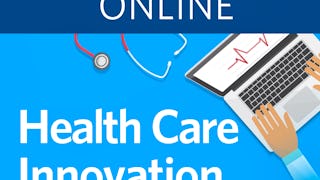This course offers a comprehensive and structured approach to identifying, validating, prioritizing, and selecting unmet, underserved, and unarticulated needs in healthcare, laying the foundation for meaningful, evidence-based innovation. Using a combination of real-world examples, stakeholder perspectives, and practical tools, learners will explore how to uncover high-impact opportunities that align with clinical, organizational, and policy priorities. Emphasizing both critical thinking and creative problem-solving, the course equips learners to assess the significance, feasibility, and strategic relevance of healthcare challenges, ultimately guiding them toward selecting the right opportunities for innovation. Whether learners plan to work in clinical care, health-tech startups, public health, or healthcare management, this course provides them with foundational tools to recognize and act on the right opportunities for innovation that are feasible, relevant, and aligned with stakeholder needs and systemic realities.


您将学到什么
The critical role of need identification in driving impactful healthcare innovation
Tools and methods for analyzing healthcare systems, meaningfully engaging stakeholders, and validating and prioritizing healthcare needs
Validating healthcare needs based on strategic, clinical, operational, and user-based criteria
Evaluating innovation opportunities based on evidence, feasibility, and organizational alignment.
您将获得的技能
要了解的详细信息

添加到您的领英档案
32 项作业
了解顶级公司的员工如何掌握热门技能

积累特定领域的专业知识
- 向行业专家学习新概念
- 获得对主题或工具的基础理解
- 通过实践项目培养工作相关技能
- 获得可共享的职业证书

该课程共有4个模块
This module lays the foundation for understanding the role of innovation in healthcare and the importance of identifying the right problems to solve. We will explore what healthcare innovation means, why it is critical in today’s evolving landscape, and the challenges and drivers that shape it. We will also learn how to categorize healthcare innovation from groundbreaking innovations to incremental advancements, understand different types of healthcare needs (clinical,operational, patient-centric), and explore the structured process for need identification and opportunity selection. This module will provide both conceptual grounding and real-world illustrations to help learners recognize impactful opportunities for healthcare innovation.
涵盖的内容
11个视频7篇阅读材料9个作业1个讨论话题1个插件
This module focuses on two foundational steps in the process of need identification for healthcare innovation—defining problems effectively and analyzing stakeholder dynamics. You will gain skills to break down complex challenges into clearly articulated problems to identify unmet needs that, in turn, lay the foundation for impactful and sustainable innovation. In addition, we will explore methods for identifying, analyzing, and engaging key stakeholders, including internal actors, such as patients and providers, and external groups, like payers, regulators, and technology partners. Using structured frameworks and practical tools, you will develop the competencies needed to ensure that innovation efforts are aligned with real-world challenges and shaped by the perspectives of the individuals most affected.
涵盖的内容
10个视频2篇阅读材料9个作业
This module aims to equip you with a comprehensive tool kit for systematically identifying unmet needs in healthcare, a critical step in driving innovation. By integrating macro-level analyses, organizational assessments, process evaluations, user-centered techniques, and rigorous research methodologies, this module provides you with a versatile and practical approach to need identification. Through real-world examples and applications, you will gain the ability to systematically analyze complex healthcare environments and uncover high-impact opportunities for innovation. Whether working in a hospital, startup, or academic setting, these tools will help you to identify meaningful needs and drive evidence-based, transformative change.
涵盖的内容
11个视频2篇阅读材料8个作业
This module builds a critical bridge between identifying problems in healthcare and transforming them into real-world innovation opportunities. We will focus on ensuring that the identified needs are worth solving; in other words, they are significant, relevant, and feasible within real-world systems. We will then examine structured methods for assessing and prioritizing needs, including the Severity-Prevalence-Feasibility (SPF) analysis, Impact-Effort Matrix, return on investment (ROI) analysis, Health Technology Assessment (HTA), and stakeholder-centered tools, like the MoSCoW Method and Multi-Criteria Decision Analysis (MCDA). Finally, we will explore how strategic alignment, resource availability, risk, and timing influence final need selection.
涵盖的内容
18个视频4篇阅读材料6个作业1个插件
获得职业证书
将此证书添加到您的 LinkedIn 个人资料、简历或履历中。在社交媒体和绩效考核中分享。
攻读学位
课程 是 University of Illinois Urbana-Champaign提供的以下学位课程的一部分。如果您被录取并注册,您已完成的课程可计入您的学位学习,您的学习进度也可随之转移。
位教师

从 Leadership and Management 浏览更多内容
 状态:免费试用
状态:免费试用University of Illinois Urbana-Champaign
 状态:免费试用
状态:免费试用University of Illinois Urbana-Champaign
 状态:免费试用
状态:免费试用University of Michigan
 状态:免费试用
状态:免费试用University of Pennsylvania
人们为什么选择 Coursera 来帮助自己实现职业发展




常见问题
To access the course materials, assignments and to earn a Certificate, you will need to purchase the Certificate experience when you enroll in a course. You can try a Free Trial instead, or apply for Financial Aid. The course may offer 'Full Course, No Certificate' instead. This option lets you see all course materials, submit required assessments, and get a final grade. This also means that you will not be able to purchase a Certificate experience.
When you enroll in the course, you get access to all of the courses in the Specialization, and you earn a certificate when you complete the work. Your electronic Certificate will be added to your Accomplishments page - from there, you can print your Certificate or add it to your LinkedIn profile.
Yes. In select learning programs, you can apply for financial aid or a scholarship if you can’t afford the enrollment fee. If fin aid or scholarship is available for your learning program selection, you’ll find a link to apply on the description page.
更多问题
提供助学金,



